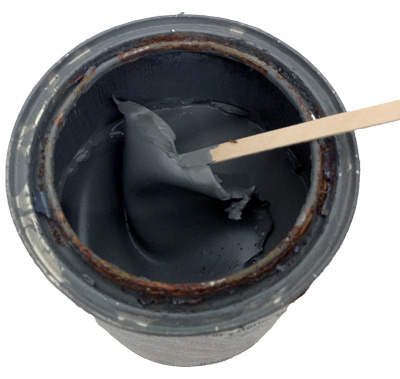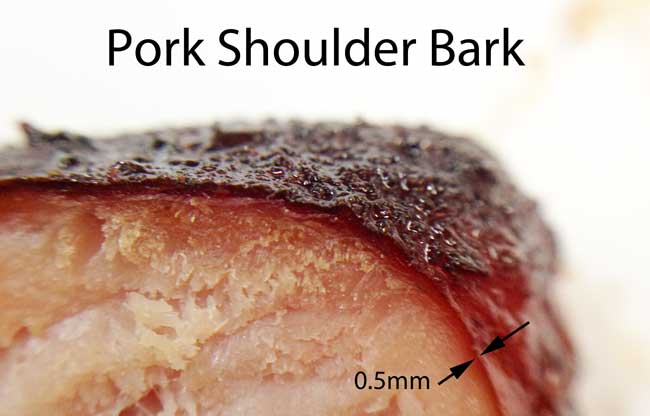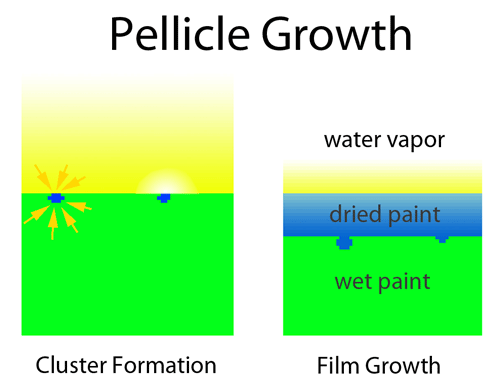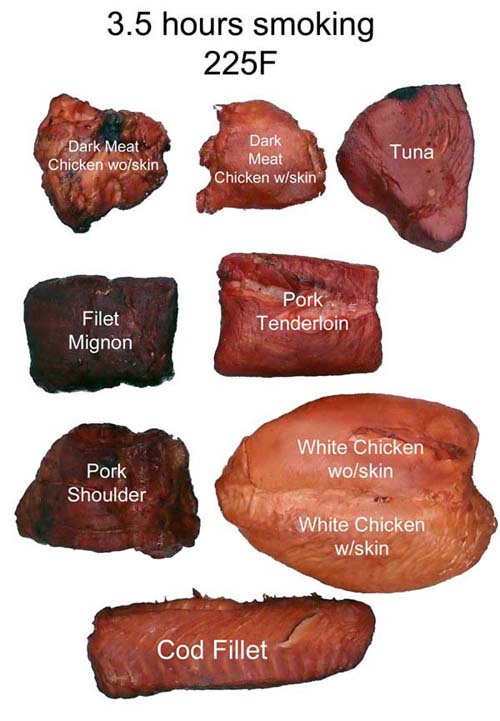| g e n u i n e i d e a s | ||||||
 |
 |
 |
 |
 |
 |
 |
| home | art and science |
writings | biography | food | inventions | search |
| watching paint dry |
|
Feb. 2013 Ever wonder how a thick skin of dried paint forms inside a metal paint can? Or why a delicious mahogany bark encases a smoked beef brisket, yet beef stew cubes are soft and gray1? Good news! Instead of trying to understand two different phenomena-- dried paint and chewy bark-- both arise from the same Diffusion Reduced Irreversible Polymerization - or DRIP process. Which is less complex than it sounds. We all know what dried paint looks like, a flexible sheet of color floating in a can that was almost, but not quite perfectly, re-sealed. Something like this:
Bark is a chewy, flavorful layer of dried meat surrounding a much moister interior. Distinct from a glaze (typically a sugar and spice mixture slathered on food that coats anything it touches with a sticky film), bark only forms on protein, and is made of protein. Glazes and barks are often found together, as in this picture of a smoked pork butt that was dry-rubbed with a sugar/salt/spice mixture on the top but not on the sides:
But the bark- that layer of flavored jerky beneath the glaze, does not need salt or sugar or fat to form. Usually less than a mm thick, this layer is called a "pellicle" (Latin for a thin skin or husk). It consists of meat proteins that dried out, broke apart chemically, and were then re-joined into a tough leathery film that remains chewy even in water.Once formed, it slows evaporation from within the meat, and penetration of flavor, from without. And just like watching paint dry, bark formation takes time. This sequence of photos taken of a thick country pork rib cooked in a pellet smoker speeds up the clock:
Without smoke, bark is a dark mahogany red. With smoke and time, it is transformed into a licorice-black, shiny lacquer. We tested bark formation after rubbing with plain, salted, sugared, acidified and basic coatings. The salt and acid rubs formed barks slightly faster, but by the time the meat was fully cooked, were more or less indistinguishable. Rendered fats provide a glistening sheen and helped moisten the bark and hold onto spices, but played no role in its creation- as determined by comparing bark on lean or marbled meat and even pure fat (which itself does not form a bark). Table sugar, surprisingly, will not darken or caramelize until it reaches a minimum temperature of 320F. Instead, the meat's color is a result of oxidation and the Maillard reaction, which turns proteins into a flavorful brown cocktail of aromatic chemicals. The Maillard reaction, unlike caramelization, starts working even at room temperature, albeit very slowly. As you can see from the above sequence, even at 225F it takes hours for the reaction to work its magic.2 But browning does not explain texture. How bark forms is, at first glance, perplexing. After all, how could the meat's surface dry out while sitting directly atop of a moist, oozing muscle? Or underneath a glaze? Though on second thought, it is no odder than paint drying inside a can, which despite a thin gap in the lid's seal, must be as humid as the jungle. Which takes us back the DRIP process- Diffusion Reduced Irreversible Polymerization. Irreversible Polymerization is a fancy was of saying that once the meat dries out and the protein molecules link up into long chains called polymers, water cannot break them apart. Dried latex paint is waterproof, dried poster paint washes off. So latex paint has irreversibly polymerized, while poster paint (to the relief of parents everywhere), can be raised from the dead by anointing with water. Thus, any process which causes meat to polymerize, even slightly, slowly accumulates and thickens the layer of bark. And here is how that process works in an open paint can: In this analogy, latex particles are blue, moisture is yellow, and wet paint (moisture +uncured latex) is naturally green. As you can see by the thinning density of yellow above the paint's surface, the air is moistest near the wet paint and drier the farther you move away from the surface towards normal room humidity.
In the left image, we note (via the yellow arrows) that while the paint is wet, the air above the paint is slightly less moist than beneath the surface (and thus has fewer water molecules impinging on the green latex paint) This is because some water molecules diffused outside the paint can, dropping their concentration inside the can. Very, very occasionally an uncured latex molecule statistically finds itself bereft of surrounding water molecules, polymerizes and dries out into a hard blue latex cluster. Because this reaction is irreversible, it does not redissolve back into the paint3. And here is where the Diffusion Reduced part of DRIP comes in. That little nodule of dried latex blocks, in its immediate vicinity, water evaporation from the wet paint (note the pale yellow above the second blue cluster). This means it is even drier near the surface than before, and thus ever so slightly more likely another latex molecule will polymerize. Over hours in the smoker, or perhaps months in a paint can, this cascade of drying events repeats, and a thin skin assembles on the surface. This continuous layer is quite resistent to water diffusion, so the moisture level above the paint drops significantly (note the thinner yellow fog on the right). The paint layer is drier on the top than the bottom, but again uncured latex molecules which touch the bottom of the skin are sometimes without a full complement of water molecules, and so the layer thickens again. Now, the bottom of the layer is pretty moist, so the pellicle grows slowly. It takes meat proteins hours to grow a mm thick in a smoker, despite the desiccating effect of air flow blowing away the moist surface fog. In a stagnant, partly sealed paint can it might take a year for the film to reach a mm's thickness. The DRIP mechanism creates a pellicle with nothing more than hot air. Pellicles occur on skinless chicken breasts baking in the oven. Or salmon fillets before cold smoking. Or even on milk proteins, by forming a skin over chocolate pudding4. In a smoker, many of the organic compounds released by burning wood will cause the meat proteins to bond together like glue on paper. Plus the smoke deposits additional sticky creosotes and phenols on top of the pellicle. So a smoker's crust is a more complex stratigraphy than our simply paint drying model allows5, but the basic mechanism remains. Since most of the flavor deposited during smoking is trapped near the surface, bark not only adds texture but delivers taste. It helps capture, and protect, smoke flavors from being washed away by mopping liquids and glazes. So burnt ends, which are all glaze and mostly bark, take pellicles to the max. Sometimes, good things come to those who wait.
|
|
-------------------------------------------------------------------------------------------------------- 1 In beef stew, the meat is immersed in broth or braised in a sealed dutch oven. In either case, there is no moisture gradient and thus no way for the surface proteins to dry out and cross-link into a pellicle. So, to build color and flavor in stew, recipes suggest browning cut meat in hot oil before braising. A combi-oven, capable of generating a 100% humidity environment, will block pellicle development. 2 If you place white table sugar in a 250F oven overnight, it will still be snowy white the next day. A chicken breast baked in 325F oven for an hour will barely tan by the Maillard reaction- the cooking time is simply too short. It takes either a long time at a low temperature, or a short time at a high temperature, or a lower pH, or very fragile proteins, for the Maillard reaction to visibly brown food. I plan on testing the effect of meat tenderizers (like pineapple juice) on bark formation- these enzymes can turn the first few mm's of meat to mush. Used with more restraint, they may deepen the bark thickness by increasing the number of severed muscle molecules which can then be cross-linked into a pellicle. 3 The dried paint cluster does not sink because paint is thick and surface tension maintains it at the air-paint interface. Depending on chemistry and humidity, the skin layer sometimes grows outward from an anchor on the side-walls. 4 You can eliminate the milk protein skin by blocking evaporation. I love the skin on chocolate pudding, but if you drape a sheet of plastic wrap directly on the just-cooked pudding, no skin will form as it cools. Similarly, some people lay a sheet of plastic wrap or parchment paper on the paint in a half-used can, just in case the lid leaks. Or they invert the can during storage. 5 Here is an example of the range of colors smoke produces on different meat species. The connection to myoglobin content will be discussed in a later article.
|
 Contact Greg Blonder by email here - Modified Genuine Ideas, LLC. |




